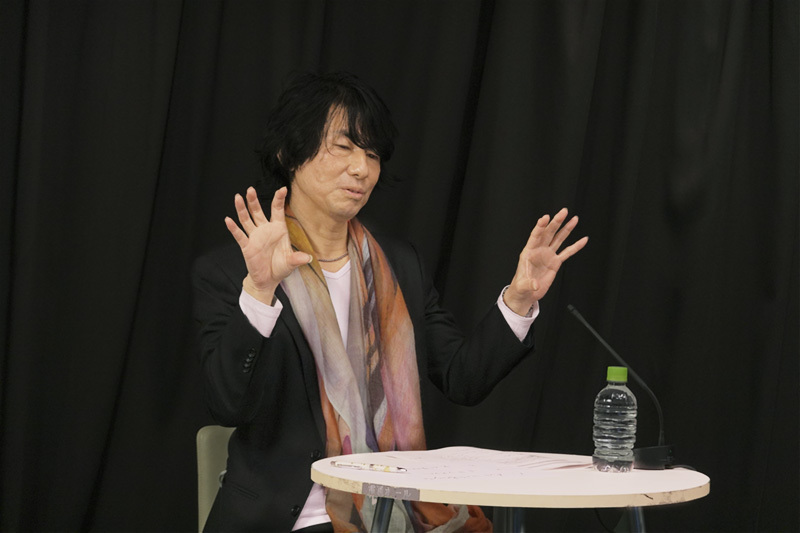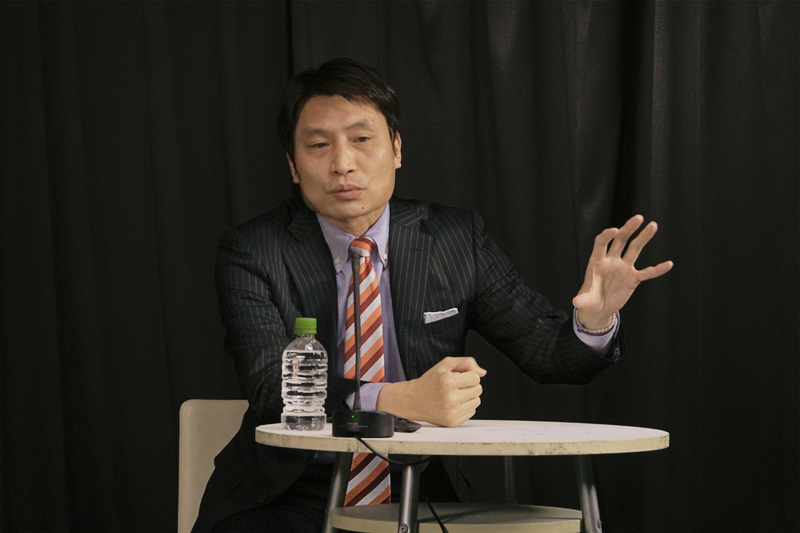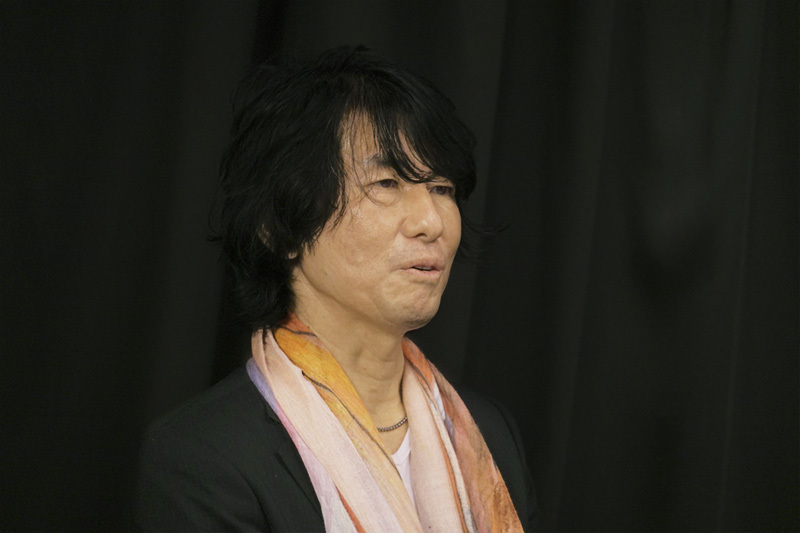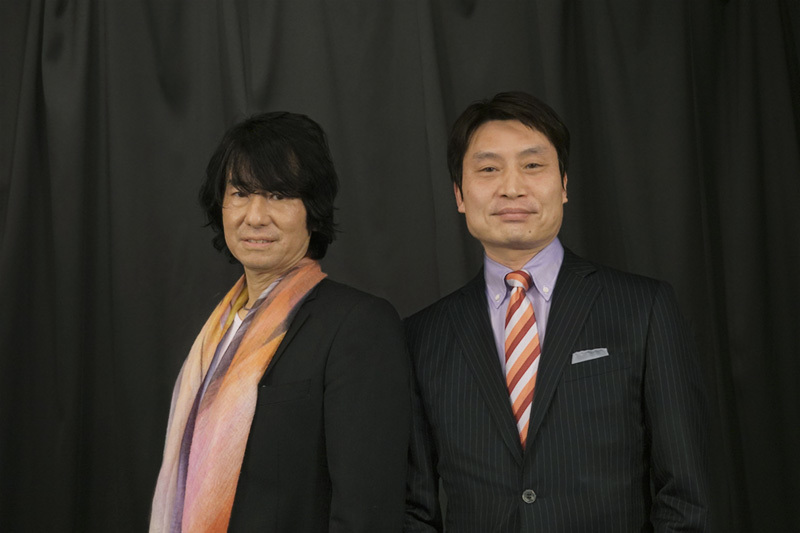Note: This website was automatically translated, so some terms or nuances may not be completely accurate.
What Future Does the Art Market Expand? (Naohiko Kurusu × Hota Hayashi)
From December 7, 2020, a five-night consecutive webinar series titled "Nights of Imagining the Future Created by Art and Business" was hosted by Dentsu Art Hub, an internal Dentsu Inc. lab dedicated to "connecting art and business to envision a prosperous future." Each session featured dialogues and trialogues among powerhouses deeply involved in art and business from their respective standpoints, all conducted under "three keywords." The "fantasy talk" themes, pre-set by the participants themselves, were enough to spark the imagination of the audience.
In this series, we aim to delve into the essence of art, the essence of business, and the grand theme of the future created by the "multiplication" of art and business, as revealed through the webinars, from the unique perspective of our editorial team.
In this fourth installment, we delve into the essence of the art market, drawing from the dialogue between Mr. Naohiko Kurisu, Representative Director of ART TOKYO, and Mr. Hota Hayashi, Assistant Director of the Cultural Economy and International Affairs Division at the Agency for Cultural Affairs.
Responsible Editor: Web Dentsu Inc. Editorial Department
"I love beautiful things. I dislike the term 'aesthetic sense'." (Naohiko Kurusu)
Mr. Kurisu's uniqueness is perhaps most evident in his "previous career." During his time at TBS, he excelled as a producer handling numerous music programs. He also demonstrated his skills in planning and developing the massive entertainment complex known as "Akasaka Sacas." His "transition" into the art world began with "Art Fair Tokyo 2015," meaning it's still relatively recent. This "recentness," or conversely, the "sense of speed" with which he achieves things, is undoubtedly a key word for understanding Mr. Kurusu.

The statement in the headline came during the latter part of the webinar and clearly reflects Mr. Kurusu's perspective on art and work. Few people would say they dislike "beautiful things." Everyone likes beautiful things. But openly stating "I like beautiful things" in public is difficult. It feels somehow embarrassing because it's too obvious.
This is also reflected in our awareness of the term "aesthetic sense." The nuance of the term "aesthetic sense" resonates with notions of virtue. The consciousness that says, "I am a sublime person who possesses aesthetic consciousness and understands virtue." Mr. Kurusu cuts straight to the heart of it, asserting that this very consciousness is what raises the barrier to art. "You must not be conscious of beauty. Once you become conscious of it, it ceases to be beautiful. After all, beautiful things should be felt purely with the heart, right? And I want to have a heart that can feel beauty purely."
"It makes me happy when the value of a piece I acquired because I loved it increases." (Hayashi Hota)
Mr. Hayashi's background is equally unconventional. After all, he's an active national civil servant. And one at the "so-called Agency for Cultural Affairs." There's a reason I just mockingly called it the "so-called Agency for Cultural Affairs." The moment you perceive culture as "high culture," its threshold becomes high. You lose sight of culture's essence and start feeling it's something lofty, something you shouldn't easily touch. To borrow a phrase you might have heard somewhere: "When it comes to high culture, we common folk can't just casually get involved, right? The etiquette seems troublesome too. And it's probably expensive, isn't it?" That sort of feeling.

Like Mr. Kurusu, Mr. Hayashi also made the headline statement during the latter part of the webinar, uttering it quietly. Taken at face value, it might seem like, "Well, well. A painting I bought for 1 million yen is now worth 3 million yen. That's a 2 million yen profit." But of course, that wasn't Mr. Hayashi's true intention. "Honestly, it's just nice when a piece you personally like gets recognized by others, right?" For example, if I were someone who absolutely loved coffee and someone said to me, "Coffee is great, isn't it? Especially the coffee at this shop. If they told me this coffee was worth 1 million yen, I'd still want to drink it," I think I'd be overjoyed, absolutely thrilled. That's probably what art is, and that's what the market expanding from it is all about.
Tonight's Keyword (Part 1): Art is a lifestyle.
For some reason, when Mr. Hayashi mentioned this first keyword, Mr. Kijima lit up with a childlike expression of delight. In fact, this phrase was the slogan Mr. Kijima adopted when producing "Art Fair Tokyo."
When thinking of a slogan, the single character "美" (beauty) immediately came to Mr. Kurusu's mind. It's very much like Mr. Kurusu, who clearly "loves beautiful things." His work style is to act immediately upon having an idea. He promptly showed the word "美" to designer Junko Koshino. "Honestly, the words she gave me back then were eye-opening," Mr. Kurusu recalls. "Listen, Mr. Kurusu. The essence of art isn't about beauty or anything like that. It's about life. Life itself is art."
When he conceived the collaboration between Art Fair Tokyo and TGC (Tokyo Girls Collection), he was searching for the common origin of art and fashion. He believed it was "beauty" and discussed this with Ms. Kosino. He'll never forget her response, "Huh? Art and fashion are no different at all," which was both humbling and frustrating.

After graduating from Waseda University, he joined Tokyo Broadcasting System (now TBS Holdings). He planned and developed projects like "Akasaka BLITZ" and "Akasaka Sacas," while also producing various performances. In 2015, he established the General Incorporated Association Art Tokyo. He serves as producer for Japan's largest international art fairs: "Art Fair Tokyo," "artKYOTO," and "art stage OSAKA." His goal is to develop Japan's art market and promote arts and culture, planning and producing various projects. He collaborates with the Cabinet Office, government ministries, local governments, and embassies to create venues for arts, culture, and international exchange. He also initiated Japan's first "Market Research on the Japanese Art Industry." Furthermore, he lectures at educational institutions such as Kyoto University and Tokyo University of the Arts, and serves as a speaker for the Liberal Democratic Party's Committee on Cultural Nation Building. He is also a Visiting Professor at Nagoya University of the Arts. He serves as a director for a kindergarten and elementary school based on International Baccalaureate education, engaging in activities to cultivate global talent. Unbound by existing frameworks, he continues his efforts to convey the potential of Japan's renowned art to the world, maintaining a panoramic view across all fields of art and culture.
Mr. Kurusu continues: "Art is a lifestyle. When you think of it that way, doesn't it suddenly feel easier, or even exciting?" You want to eat your usual favorite dish at your favorite restaurant. You want to wear your favorite fashion and go somewhere. Art should naturally blend into such daily life, into each person's unique way of living.
Under the theme "Art is a lifestyle," Mr. Kurusu initiates various projects. Among them, the collaboration between TGC and art stands out as particularly symbolic. "At its core lies beauty—the kind of everyday beauty that young girls find appealing and desirable. I sensed that this market must be enormous."
"And indeed, it expanded," testifies Mr. Hayashi, who has participated in numerous "initiatives" alongside Mr. Kurusu. Their relationship is straightforward. Under the shared goal of "Art is a lifestyle," Mr. Kurusu conceives ideas: "What if we tried this?" Mr. Hayashi responds with his expertise. Based on that expertise, Mr. Kurusu sketches the project blueprint. Mr. Hayashi then compiles the implementation schedule into a timeline. Using that timeline, Mr. Kurusu goes around persuading various people. That's the image.
Tonight's Keyword (Part 2): Ecosystem
Another keyword for the projects these two undertake is "ecosystem." It's nothing complicated. It's the "abacus" part of "reading, writing, and abacus."
Indeed, listening to Mr. Kurusu, figures (amounts) emerge at every turn. "The sales at an art fair are roughly 3 billion yen. This amount isn't about how much profit we want to make. It's about the minimum necessary to achieve what we aim for. If we can't raise this amount, no matter how well-drawn the blueprint, it becomes a pipe dream." "The live concert market is worth 250 billion yen. The art market, on the other hand, is nearly the same size at 300 billion yen. Doesn't that mean collaborating would benefit both sides?"
It's incredibly simple math, the kind even elementary school kids could understand. Yet such thinking rarely occurs to ordinary people. Mr. Kurusu's ideas also led to the creation of the "100KIN" project at Art Fair Tokyo. This initiative exclusively displayed and sold artworks priced under 1 million yen. It aimed to communicate that, starting in 2015, artworks under 1 million yen became depreciable assets.
"What's amazing about Mr. Kizumi is that his ideas are astonishingly simple, the abacus calculations (i.e., ecosystem) to bring them to life are perfectly logical, and there's always a playful element to them." It's fascinating that a bureaucrat from the "O" Agency for Cultural Affairs – an institution with an image diametrically opposed to playfulness – is pushing these projects forward with a childlike smile.

Born in 1967. Joined the Agency for Cultural Affairs in 1994. In 2003, he was responsible for launching the "Kansai Genki Cultural Zone Initiative" proposed by then-Commissioner of the Agency for Cultural Affairs, Hayato Kawai. From 2009 to 2011, he was in charge of planning and implementing measures to promote media arts (particularly animation). Following a secondment to the Ministry of Education, Culture, Sports, Science and Technology, he began research on promoting contemporary art in Japan as his life's work in June 2012. Returned to the Agency for Cultural Affairs in August 2013. While overseeing the preservation and utilization of cultural property buildings, continued planning and implementing contemporary art promotion policies under then-Commissioner Masayoshi Aoyagi. Launched the "Agency for Cultural Affairs Art Platform Project" in 2018 as a concrete initiative to foster an art ecosystem in Japan. Assumed current position in October 2018.
Tonight's Keyword (Part 3): A Nation Built on Culture and the Arts
"It feels like, since 1945, the Japanese have somehow placed art on a shrine shelf," Hayashi states. In his view, the pursuit of becoming an economic powerhouse may have led to the literal "shelving" of utilizing culture and the arts—a vital asset or resource.
The Agency for Cultural Affairs' work involves two aspects: "confronting the past" and "confronting the future," both starting from the present. It's undeniable that the former inevitably takes priority. But according to the two gentlemen's theory, art should fundamentally be rooted in daily life, existing alongside the lives of people living in the present.
On this point, Mr. Kurusu's explanation is straightforward and clear. "Art has two aspects: value and price. Japanese people understand value to a certain extent. Sometimes they even feel a sense of awe. But the moment price becomes an issue, it becomes a matter of 'we can't spend money on that' or 'we can't afford it'."
To overcome this, Mr. Hayashi emphasizes the importance of harnessing the "power of the space." Whether at home, an event venue, or anywhere else, the key is to create "a space for regular interaction with art." He argues that simply having such spaces and actually viewing numerous artworks naturally cultivates an aesthetic eye—the ability to discern quality.
Finally, a story shared by Mr. Tōzumi deeply moved me. "When visiting friends abroad, I'm always struck by how every home displays art. Instead of self-introductions, everyone happily talks about that art and always asks, 'What do you think?' Isn't that wonderful? That's why I want to expand the art market—not because I want to make money from art or boost this country's GDP. There's something far more important surrounding art."

This series is edited from the content of the webinar titled "A Night of Imagining the Future Created by Art and Business," supervised by its organizer, Kentaro Kasama (CEO of Arts & Brands), and presented from Web Dentsu Inc.
Was this article helpful?
Newsletter registration is here
We select and publish important news every day
For inquiries about this article
Back Numbers
Author

Kentaro Kasama
Arts & Brands Co., Ltd.
President and CEO
After joining Dentsu Inc., he worked in the Marketing Division and Sales Division before joining the Planning Section in 2001, where he has remained ever since. As an integrated planner/director, he provides solutions to clients across various industries by planning holistically and neutrally—from upstream areas like business strategy, marketing strategy, and branding to output areas like creative and campaigns—to solve client challenges. In recent years, he has particularly focused on implementing "Content Solutions"—collaborating with content and media in the broadest sense to solve corporate and societal challenges. He <a href= "https://newhorizoncollective.com/" >joined New Horizon Collective</a>, G.K. in 2021. He is currently the Representative Director of Arts & Brands.



